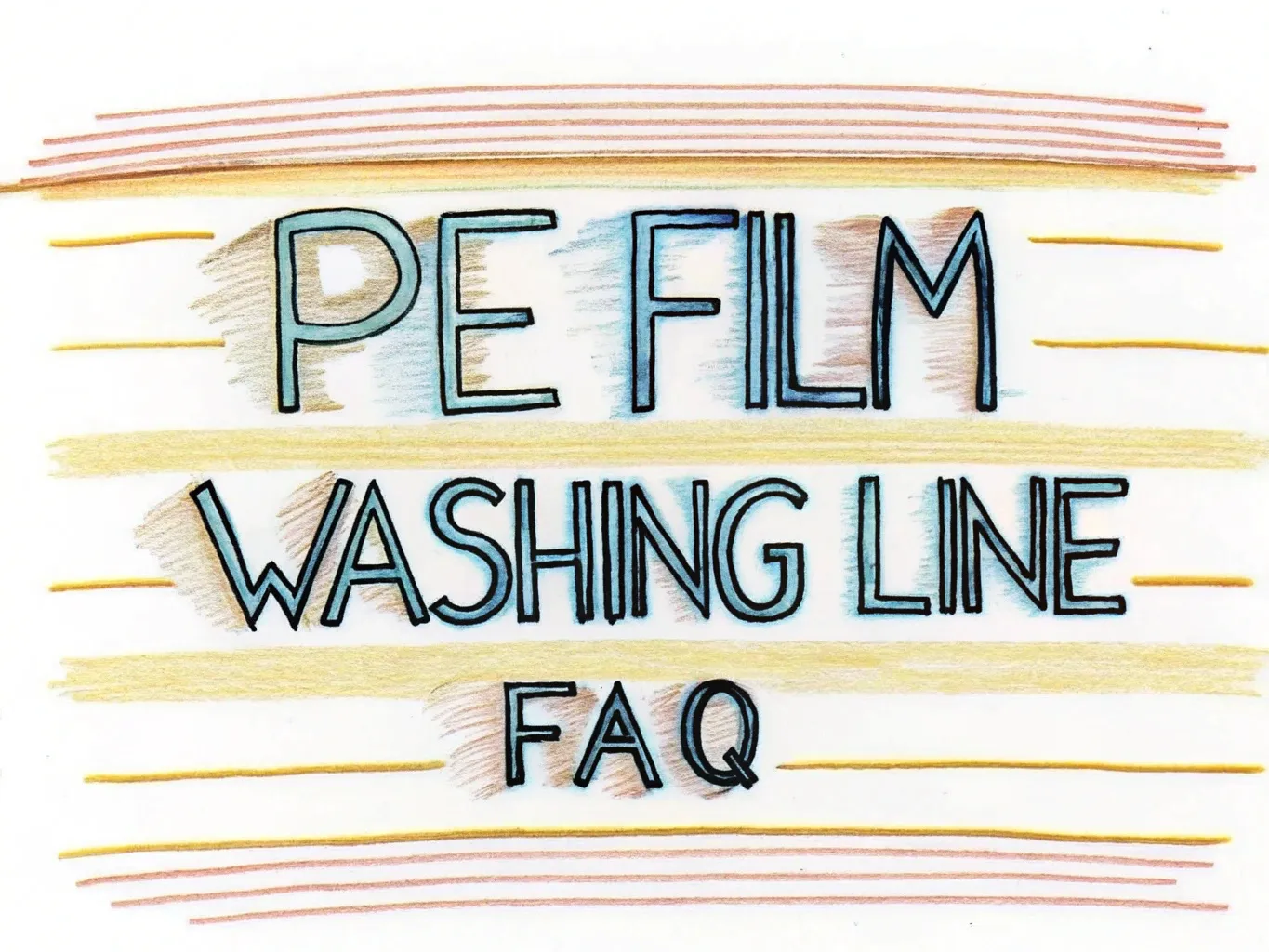The demand for sustainable solutions in plastic recycling has skyrocketed, and polyethylene (PE) film washing lines have become a cornerstone of this industry. For professionals and investors looking to capitalize on this growing market, understanding the ins and outs of PE film washing lines is critical. Whether you’re a recycling facility manager aiming to optimize operations or an investor evaluating the profitability of this technology, this FAQ guide delivers practical, actionable insights to inform your decisions. Let’s dive into the most pressing questions about PE film washing lines and uncover what makes them a game-changer in plastic recycling.
What Is a PE Film Washing Line?
A PE film washing line is an integrated system designed to recycle polyethylene films—think shopping bags, agricultural mulch, or industrial packaging—by transforming dirty, contaminated material into clean, reusable plastic flakes or pellets. The process involves shredding, washing, separating contaminants, and drying the material, all orchestrated through a series of specialized machines. These lines are vital for handling the unique challenges of PE film, such as its lightweight nature and tendency to harbor dirt, labels, or adhesives.
For professionals, this technology streamlines recycling workflows. For investors, it represents a scalable solution in a market projected to grow as environmental regulations tighten and demand for recycled plastics surges. But how does it all work, and what should you know before diving in? Let’s break it down.
How Does a PE Film Washing Line Work?
The magic of a PE film washing line lies in its systematic, multi-stage process. Here’s a step-by-step look at how it turns waste into value:
- Shredding or Granulation: Large PE film bales are broken down into smaller, uniform pieces (typically 10-20mm) using shredders or granulators. Wet granulation often adds water to pre-clean the material and reduce wear on blades.
- Friction Washing: High-speed rotors scrub the film flakes, removing stubborn contaminants like grease, soil, or adhesive residues. This step is crucial for achieving high-quality output.
- Sink-Float Separation: Using water as a medium, lighter PE film floats while heavier contaminants (sand, metal, glass) sink, ensuring effective separation.
- Hot Washing (Optional): For heavily soiled films, a hot wash with detergents tackles persistent impurities, enhancing cleanliness.
- Dewatering and Drying: Machines like screw presses or centrifugal dryers remove moisture, reducing water content to as low as 3-5%, preparing the material for pelletizing or storage.
Each stage is interconnected, often automated with conveyors, making the process efficient and hands-free—an appealing feature for operations aiming to cut labor costs.
What Types of PE Film Can Be Processed?
PE film washing lines are versatile, handling a wide range of polyethylene-based materials. Common inputs include:
- LDPE (Low-Density Polyethylene): Used in garbage bags, pallet wraps, and agricultural films.
- LLDPE (Linear Low-Density Polyethylene): Found in stretch films and packaging.
- HDPE (High-Density Polyethylene): Less common in films but occasionally processed from rigid packaging scraps.
These lines excel with soft plastics but struggle with laminates (multi-layered films), which are harder to recycle due to their complex composition. For professionals, knowing your input material is key—agricultural films, for instance, often carry more soil and require robust washing setups.
What Are the Key Benefits for Businesses?
Investing in or operating a PE film washing line offers tangible advantages:
- Cost Efficiency: Automation reduces labor needs, while energy-efficient designs (averaging 55-70 kWh/h) lower operating costs compared to standalone machines.
- High-Quality Output: Clean, dry flakes with low moisture content (under 5%) fetch premium prices in the recycled plastics market.
- Scalability: Standard lines range from 500 kg/h to 3,000 kg/h, with custom options for larger capacities, suiting both small plants and industrial giants.
- Sustainability: Recycling PE film reduces landfill waste and meets rising corporate and regulatory demands for eco-friendly practices.
For investors, the profitability lies in the growing demand for recycled PE pellets, driven by industries like packaging and construction. Professionals gain a competitive edge by delivering consistent, high-value material.
What Are the Biggest Challenges?
No system is without hurdles. Here are the top challenges in PE film washing and how they’re addressed:
- Contamination: Dirty films (e.g., agricultural mulch with soil) require extra washing stages, increasing costs. Advanced friction washers and hot wash systems mitigate this.
- Moisture Control: Excess water in flakes hampers pelletizing. Modern lines use dual drying stages—centrifugal and thermal—to hit that critical 3-5% moisture target.
- Capacity Limits: Standard setups may not suffice for high-volume operations. Custom configurations with additional shredders or washers solve this, though they raise upfront costs.
Understanding these pain points helps professionals optimize their lines and investors assess risk versus reward.
How Much Does a PE Film Washing Line Cost?
Cost varies widely based on capacity, customization, and manufacturer. Here’s a rough breakdown:
- Entry-Level (500 kg/h): $50,000–$100,000
- Mid-Range (1,000 kg/h): $150,000–$300,000
- High-Capacity (3,000 kg/h): $400,000–$800,000+
Additional costs include installation (often 10-20% of the equipment price), maintenance, and utilities (water and electricity). For investors, ROI depends on throughput and market prices for recycled PE, typically recouped within 2-5 years in a strong market. Professionals should weigh these figures against operational needs—smaller plants might start with a basic line and scale up later.
What Should You Look for in a Supplier?
Choosing the right supplier can make or break your investment. Key factors include:
- Durability: Look for machines built with high-quality materials (e.g., SUS-304 stainless steel) to withstand continuous use.
- Customization: Suppliers offering tailored solutions—extra washers for dirty films or larger silos for storage—cater to specific needs.
- Support: Prioritize vendors with robust after-sales service, including installation, training, and spare parts availability.
- Reputation: Check case studies or testimonials. A supplier with a track record of successful installations signals reliability.
For professionals, a trusted supplier minimizes downtime. For investors, it ensures the asset retains value and performs as promised.
How Does It Fit Into a Circular Economy?
PE film washing lines are a linchpin in the circular economy, closing the loop on plastic waste. By converting discarded films into raw materials for new products, they reduce reliance on virgin plastics and cut carbon footprints. Businesses adopting this technology position themselves as sustainability leaders—a selling point for eco-conscious clients and a draw for impact-focused investors.
Practical Tips for Maximizing Efficiency
Ready to get the most out of a PE film washing line? Try these strategies:
- Pre-Sort Inputs: Remove non-recyclable laminates upfront to streamline processing.
- Monitor Water Usage: Use circulating water systems to cut costs and maintain washing effectiveness.
- Regular Maintenance: Clean rotors and replace worn blades to prevent breakdowns and ensure consistent output.
- Test Output: Regularly check flake quality (moisture, purity) to meet buyer specs and maximize profits.
These steps boost uptime and product value, benefiting both operators and bottom-line-focused investors.
The Future of PE Film Washing Lines
The recycling landscape is evolving fast. Innovations like AI-driven sorting, enhanced drying tech, and energy-efficient motors are poised to make PE film washing lines even more effective. For professionals, staying ahead means adopting these upgrades. For investors, it’s a signal that this sector’s growth potential is far from tapped out.
Final Thoughts: Is It Worth It?
For professionals, a PE film washing line is a proven way to turn waste into profit while meeting sustainability goals. For investors, it’s a smart bet on a booming industry with long-term upside. By understanding its mechanics, benefits, and challenges, you’re equipped to make informed decisions—whether you’re running a plant or funding the next big recycling venture. Got more questions? The world of PE film recycling is wide open—dive in and explore the possibilities!


